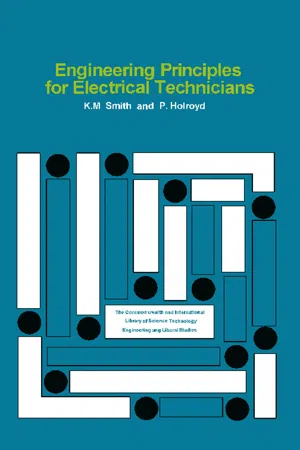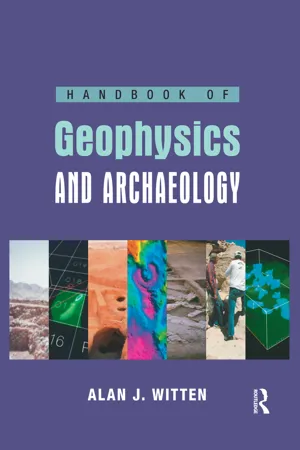Physics
Pulling Force
Pulling force refers to the force exerted when an object is being pulled in a particular direction. It is a type of mechanical force that acts in the opposite direction to the force applied to pull an object. Pulling force is a vector quantity, meaning it has both magnitude and direction.
Written by Perlego with AI-assistance
Related key terms
Related key terms
1 of 4
Related key terms
1 of 3
4 Key excerpts on "Pulling Force"
- eBook - ePub
Engineering Principles for Electrical Technicians
The Commonwealth and International Library: Electrical Engineering Division
- K. M. Smith, P. Holroyd, N. Hiller(Authors)
- 2013(Publication Date)
- Pergamon(Publisher)
CHAPTER 1Forces and Equilibrium
Publisher Summary
When we think of forces we usually consider the action of lifting a weight, bending a piece of wire or setting a vehicle in motion. Whenever we move, or move other objects around us, then forces are brought into play. One of the most important forces is the one that causes objects to fall downwards, the Force of Gravity. This chapter discusses the types of force, effects of forces, and the equilibrium of forces. The effect of a number of forces acting on a body depends not only on the magnitude of the forces and their directions, but also on the points at which the forces are applied to the body. This action of the force turning about an axis or fulcrum is called the turning moment or moment of the force, or torque. The chapter also presents the experiment to find the coefficient of friction between two surfaces in contact.1.1 Types of force
When we think of forces we usually consider the action of lifting a weight, bending a piece of wire or setting a vehicle in motion. Whenever we move, or move other objects around us, then forces are brought into play. In fact, approximately three centuries ago Sir Isaac Newton gave us a definition of a force which includes all the forces that we can imagine. “Force changes or tends to change the state of a body’s rest or uniform motion in a straight line.” One of the most important forces we meet is the one which causes objects to fall downwards, the Force of Gravity .It has been found that between all bodies there is a force of attraction defined as the gravitational force. The larger the bodies the greater the attraction between them, but as the distance between the bodies increases the attraction decreases. Normally bodies on the surface of the earth do not show this attraction between themselves because the force is very small, but if we consider two masses, one of which is the earth, then the force of attraction between these masses can be considerable. The earth being the larger body will not move perceptibly and therefore the smaller body, if free to do so, will move towards the centre of the earth. This force of gravity acting on the body is called its Weight - eBook - ePub
Biomechanics of Human Motion
Applications in the Martial Arts, Second Edition
- Emeric Arus, Ph.D.(Authors)
- 2017(Publication Date)
- CRC Press(Publisher)
pulling actions . To better understand the pulling actions of the muscles, here is the explanation: When you pull a cart, you say there is a pulling action of the biceps muscle. But when you push a table, you probably will say there is a pushing action. It is not! You have to think about your muscle’s actions again. In this case, the triceps muscle pulls the forearm for the extension position that results in a pulling action of the triceps muscle even if your arms are extended. For a popular explanation you should say my body is pushing an object or better the object will depart from your body.8.2.1 Force of GravityFor a freely falling object, the only force is the force due to gravity (commonly called the weight). If the only force acting on an object is its weight, we find that the acceleration is independent of the mass of the object. The gravitational force is a vector that always points straight down. Weight is the magnitude (or size) of the gravitational force acting on an object; since weight is a magnitude of a vector, it is always a positive quantity, weight (w ) = m ⋅ g.8.2.2 Specification of ForcesWhen a biomechanist wants to find out the forces acting on a body, he uses the so-called rigid body model analysis, which should include different forces acting on the body, direction of those forces, and their effect on the body in case. A rigid body represents an object that tends not to change shape when forces are applied to it. We know that the human body is not rigid at all. Different body parts/segments are linked together with joint systems. Also, we know that each segment has a fixed mass with a CoM located at a fixed point.From this assertion, the biomechanist considers the body as a rigid link composed of stick figures. By having this stick figure we can use the so- called sticks as vectors with their directions and we can use resultants by using trigonometry and different calculations to find out the forces. - eBook - ePub
Primary Science
Knowledge and Understanding
- Jenny Kennedy(Author)
- 2013(Publication Date)
- Routledge(Publisher)
- A force is needed to make an object start to move, to make it go faster, slow it down, stop it or make it change direction. In other words, a force is needed to change the movement of an object. If something is not moving, we can in almost every case conclude that the forces acting in each direction on the stationary object balance one another. A stationary object which has no force at all acting on it will not move. Without a force to slow down a moving object (i.e. ‘change its movement’), the object will carry on going straight at a steady speed. Applying a single force to it would make it go faster and faster – i.e. accelerate – or decelerate, or change direction, depending on the direction of that force.
- Forces always occur in pairs. If I exert a force on you, you will exert a force of the same size on me, although it will be in the opposite direction.
- If two compact, relatively heavy objects are dropped at the same time, they each pick up speed at the same rate, reaching the ground together – even if their weights differ.
- The Earth’s gravity pulls all objects toward the centre of the Earth – holding objects on its surface and pulling down falling objects. We call the force of gravity on an object its weight.
- Magnetic forces also act through space. A north pole attracts a south pole, but two similar poles (both south poles or both north poles) repel each other. A magnet will attract iron and other magnetic materials.
- When forces are applied to two surfaces in contact, to make them slide over one another, the force of friction comes into play. It acts against the direction of movement, slowing objects down, and can prevent movement altogether. Friction can be a hindrance in some cases, but a help in others. Friction forces are needed for rolling to occur.
- eBook - ePub
- AlanJoel Witten(Author)
- 2017(Publication Date)
- Routledge(Publisher)
2 Gravity: The Pull of the EarthGravity is a force of mutual attraction between two masses and it will be shown here how this force can be exploited to detect and locate shallowly buried objects. Further discussions of gravitational force require more explanation of what is meant by force, mass, and other quantities, such as density, volume, acceleration, vectors, and scalars. These discussions will be presented throughout this chapter but, for the moment, consider the two masses, m and M, illustrated in Fig. 2.1 separated by a distance R.Figure 2.1. Geometry used in the definition of gravitational force.The gravitational force acting between these two masses is the product of the masses mM and varies inversely proportional to the square of their separation R.A very basic definition of force is a quantity that causes motion or a change in motion. Thus, a gravitational force can induce a motion in either of the two masses. It is impossible to determine if m is stationary and M moves towards m, M is stationary and m moves towards M, or both masses move towards each other. The perception of motion depends on the reference frame from which observations are being made. An intuitive example of this is the perception of motion within a moving train. Stationary objects outside of a moving train appear to be in motion when viewed from within the train. Although the train is in fact moving, it can appear stationary, with external objects moving when they are observed from a reference frame within the train.With geophysical measurements made on or near the surface of the Earth, it is assumed that the Earth is stationary and objects on or above its surface move towards it under the force of gravity. Thus, elevating an object above the surface of the Earth and subsequently releasing it will result in its 'falling' back to the surface of the Earth.Thus far, the discussion of gravity has been limited to forces between two masses. A more complete understanding of gravitational forces requires an understanding of the forces among many masses. For example, consider the three masses shown in Fig. 2.2. If it is assumed that massesMlandM2each exert a force on mass in, a question arises as to the nature of the motion induced on m
Index pages curate the most relevant extracts from our library of academic textbooks. They’ve been created using an in-house natural language model (NLM), each adding context and meaning to key research topics.
Explore more topic indexes
Explore more topic indexes
1 of 6
Explore more topic indexes
1 of 4



